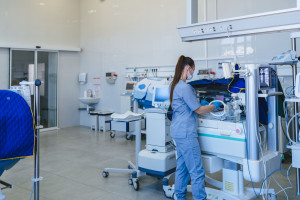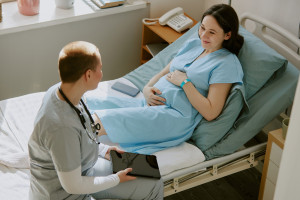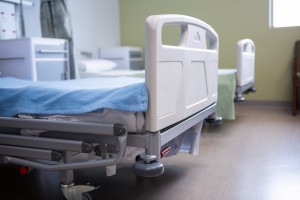Deputy Minister on the details of the new solution for women giving birth: an intermediate station instead of a delivery room

- - The ministry is currently analyzing the availability of maternity wards in Poland - Deputy Minister Tomasz Maciejewski told the editorial office of Rynek Zdrowia during the 21st Health Market Forum
- As he argued, maternity wards, where a small number of deliveries take place, are not the safest place for women giving birth
- He reminded that a draft regulation is under consultation, which talks about a new "product" that is supposed to solve the problem of white spots after the liquidation of some branches.
- "Where there is no maternity ward, a midwife will be on duty in the emergency room or admissions room," he explained. She will deliver the baby or decide whether to transport the pregnant woman, also with the help of the Air Ambulance, to a specialized ward.
"Analyses are underway to assess the accessibility of maternity wards in Poland, as well as their operational range, including travel times. These analyses are well advanced and have already been discussed with the national supervisory authority, including the national consultant and provincial consultants in obstetrics and gynecology, the national consultant in neonatology, and the national consultant in obstetrics and maternity nursing. We have already discussed this topic with them," Deputy Minister of Health Tomasz Maciejewski said in an interview with Rynek Zdrowia.
He recalled that a draft regulation is currently under public consultation, which discusses a new "product" within the National Health Fund (NFZ) contracting framework . This is intended to ensure the safety of pregnant and childbearing women in areas where access to healthcare facilities is already difficult, and where facilities have been closed.
"Catch patients with risk factors"As the deputy minister explained, this will mean that "in a given place, within the emergency department or admission room, there will be a point where a midwife will be on duty, where there will be a medical rescue team and if it is impossible to get the woman giving birth to the hospital, she will be able to give birth safely there."
- This point is intended to be a place to ensure a possible delivery if it is impossible to reach the designated obstetrics and gynecology ward - added the deputy minister.
- There must also be a clinic open daily from 8 a.m. to 6 p.m., 5 days a week, he said.
Moreover, as he explained, this clinic is also intended to be a place "to identify patients with risk factors and they should be provided with care by specialist centers, not by the district department at the first level of obstetric care."
An intermediate station for women giving birth- The Air Ambulance Service has expressed its full readiness and is ready to transport a pregnant woman or a woman with a newborn as part of its duties, as they are also trained in this area and are also ready to perform their tasks if necessary - he assured.
He explained that the idea is to provide a sort of intermediate station if the journey to the maternity ward is longer . If a woman arrives by car, she will still be provided with medical transport to the appropriate ward.
"There will be a lot of involvement of midwives there. (...) And this is a place we want to launch now, because we know that such gaps are starting to appear," admitted the deputy minister.
At the same time, he stated that the ministry is working primarily on rationally organizing care for pregnant women in Poland, adapting it to demographic conditions and the year-on-year decreasing number of births.
- So we will need fewer maternity wards - he admitted, also pointing out that "for a ward to be safe for a woman giving birth, an appropriate number of procedures must take place there so that the staff can provide appropriate assistance."
A crucial 25 km and better access to maternity wards. Changes starting in the new year."If there's less than one birth a day, it's really not the safest place for women to give birth," he said.
The regulations are intended to enable the provision of care to pregnant or giving birth women by service providers providing services in IP or ER in locations more than 25 km from the nearest maternity ward.
If hospitalization in an obstetrics and gynecology or neonatology department is indicated, transport will be provided and the woman or newborn will be transferred to the care of another service provider with such departments.
As we read in the OSR, it is planned that the guaranteed service will be provided by a midwife through:
- assessing the clinical condition of a pregnant or giving birth woman,
- detection of risk factors and early detection of pathologies during pregnancy, childbirth or the postpartum period, as well as issuing recommendations to the pregnant woman regarding further treatment, nutrition, care or lifestyle,
- ensuring continuity of care for the woman giving birth during labour or the postpartum period and for the newborn.
Moreover, if hospitalization in an obstetrics and gynecology or neonatology department is indicated, transport and transfer of the pregnant woman, woman giving birth, woman in postpartum period or newborn to the care of another service provider with the above-mentioned departments will be ensured.
A facility providing the service " Midwife-provided care for pregnant or laboring women " will be required to provide access to a means of transport adapted to transport pregnant, laboring, or postpartum women, or newborns. Transport will be provided by a team consisting of three healthcare professionals, including a midwife and two paramedics, the Ministry of Health explains in its OSR.
The regulations are scheduled to enter into force on January 1, 2026.
Copyrighted material - reprint rules are specified in the regulations .
rynekzdrowia











